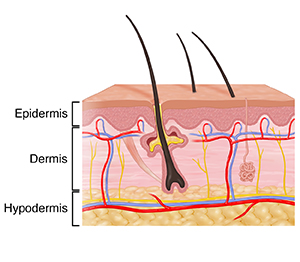Nonmelanoma Skin Cancer: Introduction
Getting a cancer diagnosis
It can be shocking to learn that you or someone you care for has cancer. Feeling upset or discouraged when you get this kind of news is only natural. But remember: You are not alone on this journey. And even though a diagnosis can be scary, it’s the first step toward treatment.
What is nonmelanoma skin cancer?
Cancer starts when cells in the body change and grow out of control. Most cancers involve a lump or mass of these abnormal cells, also known as a tumor. If cancer cells go undetected for long enough, they might spread into nearby tissues or other parts of the body. This process is called metastasis.
Skin cancer develops in the cells of the skin and often appears as a lesion. There are several types of skin cancer. One major type is nonmelanoma skin cancer, which includes:
Understanding the skin
The skin is the largest organ of the body. It protects us from heat, sunlight, injury, and infection. It also stores water and fat, and makes vitamin D. The skin has 3 layers:
-
The outer layer called the epidermis
-
The middle layer called the dermis
-
The inner, deep layer called the hypodermis, or subcutaneous tissue
A quick refresher on the epidermis: It’s made up of thin, flat cells known as squamous cells. Then underneath the squamous cells are round basal cells. Many nonmelanoma skin cancers start in the epidermis.

What are the different types of nonmelanoma skin cancer?
Basal cell carcinoma
Basal cell carcinoma is by far the most common type of skin cancer. As the name implies, basal cell carcinoma starts in the epidermis in your skin’s basal cells.
-
Where is it commonly found? Sun-exposed areas, like the face, head, neck, arms, and hands
-
What does it look like?
-
-
Small, raised, shiny, or pearly bumps
-
Crusty, itchy patches
-
Flat white or yellow spots
Nearly all cases can be cured. It grows slowly and rarely spreads to other parts of your body. Treatment helps prevent this cancer from growing deeper into bone and tissues under the skin, which can cause serious damage. Sometimes, basal cell carcinoma comes back after treatment. And having basal cell carcinoma puts you at higher risk for new ones in other places as well as other types of skin cancer.
Squamous cell carcinoma
Squamous cell carcinoma is the second most common type of skin cancer. It starts in the flat squamous cells in the upper part of the epidermis.
-
Where is it commonly found?
-
Sun-exposed areas, like the face, ears, lips, head, neck, arms, and hands
-
Genital area
-
In scars
-
In long-lasting skin sores
-
What does it look like? Appearance varies, but it often shows up as a rough, scaly, wart-like, reddish patch
Squamous cell carcinoma tends to grow quickly. But this cancer rarely spreads to other parts of the body. Most cases of squamous cell carcinoma are found early enough to be treated and cured.
Merkel cell carcinoma
Merkel cell carcinoma is a very rare type of skin cancer. It starts deep within the upper layer of your skin. Merkel cells are very close to nerve endings and help your skin sense light touch.
-
Where is it commonly found? Sun-exposed areas, like the head and neck (but it can start anywhere on the body)
-
What does it look like? Firm, shiny lumps that don’t hurt. These lumps may be red, pink, or blue.
A Merkel cell cancer tumor tends to grow really fast. So the sooner it is detected, the easier it is to treat before it can spread beyond your skin.
Cutaneous lymphoma
Cutaneous lymphoma is also known as lymphoma of the skin. It’s a type of non-Hodgkin lymphoma, a cancer that starts in blood cells called lymphocytes. These white blood cells normally fight infections as part of your immune system.
Cutaneous lymphoma causes scaly patches or bumps and develops over many years. There are several different sub-types based on what kind of white blood cell the cancer starts in, how the cancer cells look, and proteins found on the cancer cells.
Kaposi sarcoma
In Kaposi sarcoma, cancer starts in the cells that line lymph or blood vessels. It can cause lesions on the skin. There are 4 main types of Kaposi sarcoma, but the cancer cells look almost the same in all of them.
-
Where are skin lesions commonly found?
-
What does it look like? Purple, brown, or red patches on the skin, in mucous membranes (like the inside of the mouth), or in internal organs
Rely on your healthcare provider
It’s normal to feel uncertain about what comes next. Just remember that you are not alone. If you have questions about nonmelanoma skin cancer, reach out to your healthcare provider. They’re here to help you understand more about your diagnosis and walk with you every step of the way.